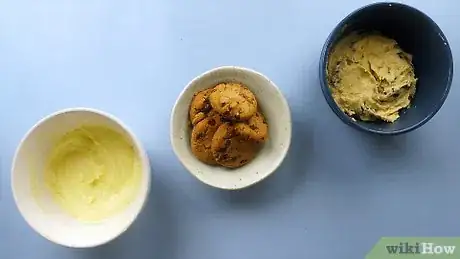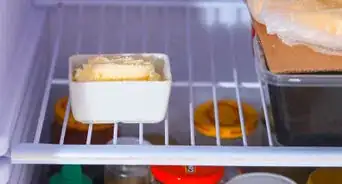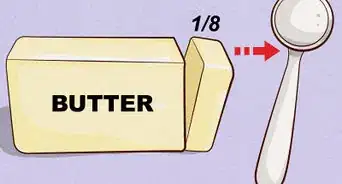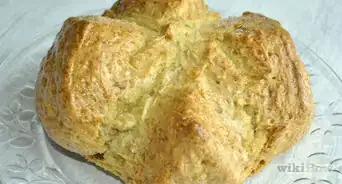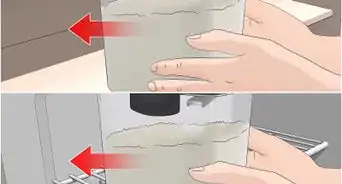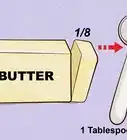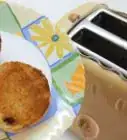This article was co-authored by Sarena Nelson. Sarena Nelson is a Private Chef and the Founder of Chef Sarena, based in Palm Springs, California. With over 10 years of experience, she specializes in customized menus for private events, has worked in 5-star restaurants, and has helped small restaurants redesign their menus. She earned her degree from Le Cordon Bleu School of Culinary Arts in Pasadena, California.
This article has been viewed 338,021 times.
Creaming butter is the process of mixing butter and sugar together to create a soft and creamy state for use in baking. It's a common skill in baking that ensures even distribution of the butter through the cake mixture. It also introduces air to the mixture, helping it to rise. For these reasons, it is important to master the skill of creaming butter.
Ingredients
- Softened butter
- Superfine white sugar
Steps
Softening the Butter
-
1Microwave the butter. If you're really in a rush, you can also cheat by warming the butter in the microwave. Be very careful with this though - if the butter melts, it will not cream properly and you will have to start again with new butter. To microwave:
- Cut the cold butter into even-sized chunks (this will ensure that they soften evenly), place the chunks in a microwave-safe bowl, and heat for no more than 10 seconds.
- Take the bowl out and check the butter - if it is still too hard, place it back in the microwave for 5 seconds at a time.
-
2Allow the butter to reach 60 degrees Fahrenheit (15.5 degrees Celsius). Take the butter out of the fridge about 10 minutes before you intend to work with it, and cut it into 1/4 in (6.45 mm) pieces. Cold butter does not blend well when mixed and will leave chunks of butter throughout the finished product.[1]
- While "room temperature" is standard advice, slightly cooler than room temperature is actually better. Once the butter reaches about 70 degrees Fahrenheit (21 degrees Celsius), it's too warm to retain much air, which can result in denser baked goods.
- For best results, test the temperature using a digital thermometer. If you don't have one, you can test the butter by giving it a poke with your fingers; if the butter is soft as a ripe peach and your fingers easily leave an indentation, it's ready to use.[2]
- However, if the butter is squishy and shiny it has probably started to melt, which is not ideal for creaming. Place the butter back in the fridge for 5 to 10 minutes until it firms up a little.
Advertisement -
3Grate the butter. Don't worry if you forget to take the butter out of the fridge in advance - all chefs forget from time to time. You can cheat by using a cheese grater to grate the hard butter into thin strips. The increased surface area will allow the butter to soften very quickly and you'll be ready to cream in no time.
Creaming by Hand
-
1Place your softened butter in a mixing bowl. You can use any type of mixing bowl you like, however, some chefs recommend using a ceramic or stoneware bowl for creaming butter.
- These types of bowls have rougher surfaces which catch the butter and speed up the creaming process.[3]
- Metal or plastic bowls have smoother surfaces which do not catch the butter.
-
2Start mixing the butter. Before you add the sugar to the bowl, you should cream the butter on its own first. This will make adding the sugar much easier later on.
- Use a fork, wire whisk, spatula or wooden spoon to mush up the butter before you begin to mix.
- Like with the ceramic or stoneware bowl, it is believed that a wooden spoon will catch the butter more easily and speed up the creaming process.
-
3Gradually add the sugar. Little by little, incorporate the sugar into the butter, beating after each addition. This will give the sugar a chance to dissolve and prevent it from flying out of the bowl as you mix.
- Continue beating the butter and sugar once all of the sugar has been added. Beat vigorously but steadily - you will have to work at it for a while so you don't want to tire yourself out too soon! Switch hands if you need to.
- Just think of all the calories you'll burn while beating - you'll certainly deserve that extra cookie once they're done!
-
4Know when to stop beating. Really with hand beating there's no way to over-mix the butter and sugar...but you'll have to stop at some point.
- When it's ready, the mixture should be creamy and lump-free. It should be slighter paler in color too.
- A good test is to drag a fork through the mixture - if you see any streaks of butter, you'll need to keep beating, if not you can continue with your recipe.
- If you leave streaks of butter in your mixture, this means that it's not uniform and your final product will have an uneven texture.
Using a Mixer
-
1Place the softened butter into a suitable mixing bowl. Beat the butter with a hand-held or stand mixer on a low speed, until it becomes soft and creamy.
-
2Start adding the sugar gradually. Add the sugar to the butter a little at a time. The purpose of adding it slowly is to allow you to work it into the butter so that it dissolves and doesn't leave lumps or granules of sugar in the mixture.
- As the sugar is beaten, it cuts through the butter, leaving bubbles of air behind. This aerates the mixture, allowing it to rise and giving the final product a light, fluffy texture.
- Most recipes will call for caster or superfine sugar when creaming butter. This is because superfine sugar has the perfect consistency for creaming - it has enough of a surface area that it will adequately aerate the butter as it is beaten (unlike powdered sugar), but it is fine enough that it will not give a coarse texture to cakes and cookies (unlike granulated sugar).
-
3Increase the speed of the mixer. Once all of the sugar has been added to the butter, increase the speed of the mixer (high on a hand mixer, medium/high on a stand mixer) and continue beating until the entire texture is smooth and creamy.
- Don't forget to scrape down the sides of the mixing bowl with a rubber spatula from time to time, to reincorporate any sugar or butter that has stuck to the sides.
- Also try to scrape out any mixture that has become trapped in the beaters.
-
4Know when to stop mixing. As you continue to beat, the butter and sugar mixture will increase in volume and become increasingly lighter in color. When the sugar and butter has been perfectly creamed, it should be off-white in color and have almost doubled in volume. The texture should be thick and creamy - almost like mayonnaise.
- Be careful not the over-mix the butter and sugar. Once the mixture is pale and creamy, and forms slight, soft peaks, you should stop beating.
- If you keep mixing, it will lose most of the air you worked in and the final product will not rise very well.
- As a guideline, your butter and sugar should be perfectly creamed in about six or seven minutes, when using a mixer.
-
5Use as required in your recipe. If you've creamed the butter and sugar well, the baking process should proceed smoothly.
Expert Q&A
Did you know you can get premium answers for this article?
Unlock premium answers by supporting wikiHow
-
QuestionHow do you keep butter fresh at room temperature?
 Sarena NelsonSarena Nelson is a Private Chef and the Founder of Chef Sarena, based in Palm Springs, California. With over 10 years of experience, she specializes in customized menus for private events, has worked in 5-star restaurants, and has helped small restaurants redesign their menus. She earned her degree from Le Cordon Bleu School of Culinary Arts in Pasadena, California.
Sarena NelsonSarena Nelson is a Private Chef and the Founder of Chef Sarena, based in Palm Springs, California. With over 10 years of experience, she specializes in customized menus for private events, has worked in 5-star restaurants, and has helped small restaurants redesign their menus. She earned her degree from Le Cordon Bleu School of Culinary Arts in Pasadena, California.
Private Chef
-
QuestionCan I use margarine instead of butter for creaming?
 wikiHow Staff EditorThis answer was written by one of our trained team of researchers who validated it for accuracy and comprehensiveness.
wikiHow Staff EditorThis answer was written by one of our trained team of researchers who validated it for accuracy and comprehensiveness.
Staff Answer wikiHow Staff EditorStaff Answer
wikiHow Staff EditorStaff Answer -
QuestionWhat sorts of cakes need creaming?
 wikiHow Staff EditorThis answer was written by one of our trained team of researchers who validated it for accuracy and comprehensiveness.
wikiHow Staff EditorThis answer was written by one of our trained team of researchers who validated it for accuracy and comprehensiveness.
Staff Answer wikiHow Staff EditorStaff Answer
wikiHow Staff EditorStaff Answer
Warnings
- If the butter is not creamed enough when the recipe calls for this, there is a risk of finding holes in the cake.⧼thumbs_response⧽
- Over-beating will cause the butter to melt. Melted butter cannot be used in recipes calling for creamed butter!⧼thumbs_response⧽
Things You'll Need
- Mixing bowl
- Whisk or spoon or electric mixer for beating
- Recipe
References
About This Article
To cream butter, soften it first by leaving it out at room temperature or microwaving it for 10 seconds. Then, put the softened butter in a large bowl and gradually mix in sugar. Once you've added all the sugar, quickly mix the butter until it's thick and creamy. When the butter and sugar are thoroughly mixed, you're finished. If you want to learn how to use an electric mixer for making cream butter, keep reading the article!


